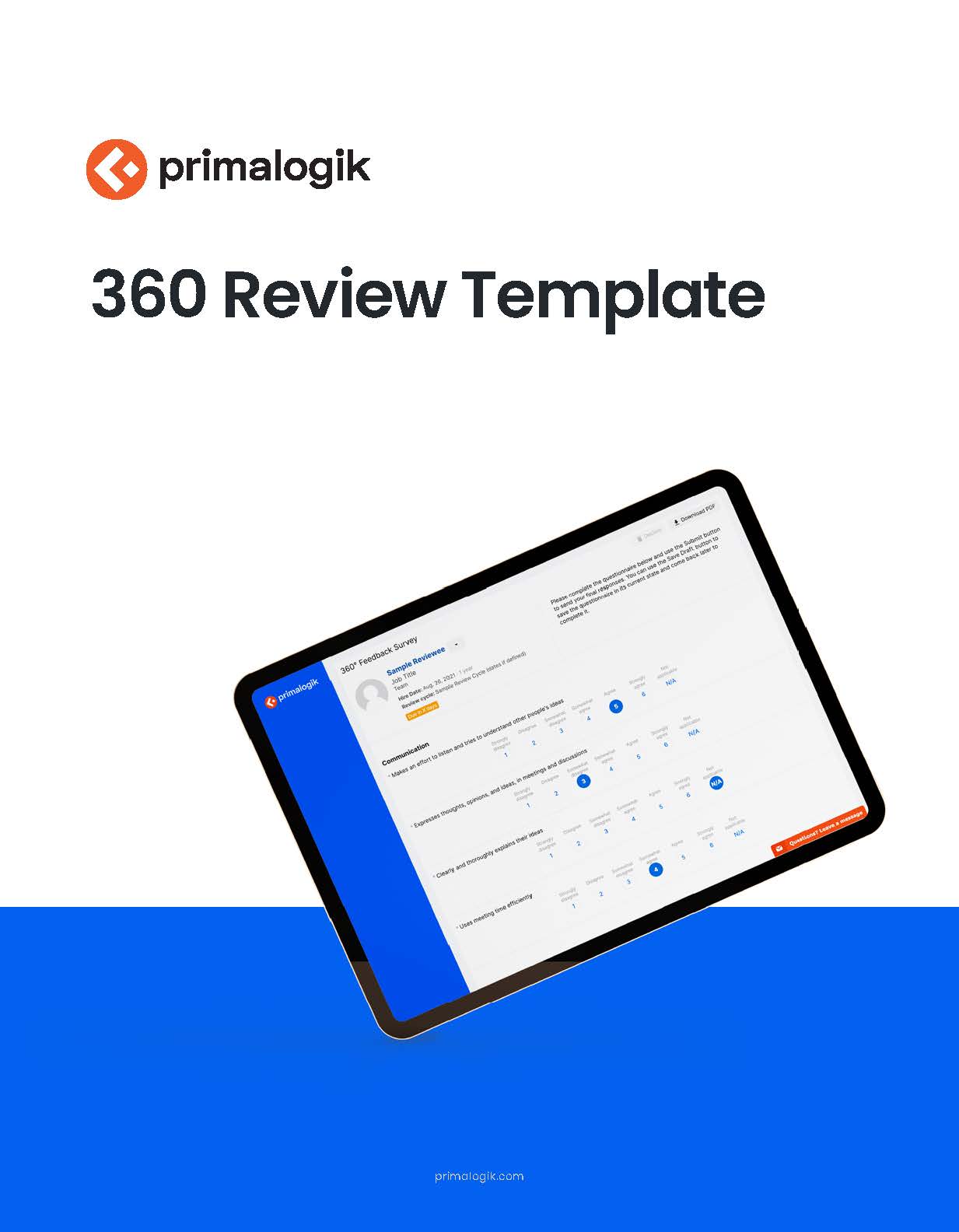A 360-degree performance review provides the comprehensive view needed to truly understand an employee’s impact. The critical element in this process? The 360 feedback review questions. These questions allow employers to gain an in-depth understanding of their employees. They can also be used to help employees learn how various colleagues view their performance.
Selecting insightful and well-crafted 360-degree feedback questions is key to obtaining meaningful and actionable data. In short, the effectiveness of a 360 performance review hinges on the quality of its foundation: the survey questions themselves.
Here, we will delve into why choosing the right 360 review questions is critical. We will then explore which types of questions are the most helpful, and which types are best to avoid. This 360 degree multi-rater feedback approach is a cornerstone of talent management, and is used across the globe by highly competitive companies. Let the HR professionals at Primaoligik help you make the most of this powerful performance management tool!
Navigation
1. What Are 360 Degree Feedback Questions?
2. Why Choosing Good 360 Review Questions Is Important
3. How to Formulate Good 360 Feedback Questions
4. Types of 360 Feedback Questions
5. 360 Feedback Questions for Employees and Managers
6. How to Get the Most Out of 360 Surveys
7. How to Answer 360 Feedback Questions
8. Design Effective 360 Review Questions With the Right Performance Management Software
What Are 360 Degree Feedback Questions?
360-degree performance review questions are the specific inquiries used in a multi-rater feedback process.
Unlike traditional performance reviews where feedback primarily comes from a direct manager, 360 reviews gather comprehensive input from a range of individuals who work with the employee, including colleagues, supervisors, and direct reports. They aim to uncover as much useful information as possible about an employee’s professional goals, needs, workplace satisfaction and experience.
These questions do not delve exclusively into an employee’s performance and accomplishments, but rather emphasize their professional development and evolution. Questions typically target specific observable behaviors, skills, and competencies relevant to the employee’s role and the organization’s values, such as communication, teamwork, problem-solving, leadership, and initiative.
You might see 360 reviews with 30 to 60 questions in total. Some can be shorter (around 20-30) or longer (up to 70-90), but longer surveys can lead to rater fatigue and less thoughtful responses. In general, it shouldn’t take more than 10-20 minutes to answer them all.
360 review questions can be formulated in a variety of ways, including rating scales (such as the Likert Scale), open-ended questions, yes/no questions or “start, stop, continue” questions.
To encourage honest and candid feedback, responses from individual raters (excluding the direct manager in most cases) are usually kept anonymous when compiled into a report for the employee.
The specific questions used should be customized to the specific job roles being reviewed and align with the organization’s performance management goals and competency frameworks.
There you have 360 review questions in a nutshell! Now let’s get into the details.
Why Choosing Good 360 Review Questions Is Important
Choosing good 360 review questions is the most important step in designing an effective 360 degree review. The right questions will allow you to collect actionable, balanced, and insightful feedback that drives employee growth, enhances self-awareness, and supports a healthy organizational culture. Poorly chosen questions, on the other hand, can result in vague, biased, or unhelpful feedback, undermining the entire review process.
Bad 360 feedback questions include “yes or no” questions that don’t provide real insight. Employees may learn what others think of them but not how to make improvements, leaving them feeling demoralized and disempowered. This in turn can contribute to a toxic work environment, when your review process should actually be attempting to do the opposite.
For example, questions such as the following are less helpful:
Does this employee…
- Manage others effectively?
- Care about others?
- Communicate well?
While those are important issues, these questions are not specific enough. They’re also very subjective since they’re not behaviour-focused.
Good 360 feedback questions help employees identify their strengths, uncover blind spots, and find areas for potential growth. While employees may feel surprised by the results at times, you know you are on the right track if your questions are opening doors for growth and stimulating productive professional discussions.
How to Formulate Good 360 Feedback Questions

Good 360 feedback questions should serve multiple purposes. Using a well-designed template can help you choose the right questions for your organization, and take into consideration the broader goals of this process. Let’s take a look at a few examples of what your question should accomplish:
1. Drive meaningful employee development
Well-crafted 360 review questions help employees identify their strengths, uncover blind spots, and pinpoint areas for growth. The idea is to promote both personal and professional development by generating answers that will help employees take actionable steps toward improvement.
Sample question:
What skills could this employee improve upon, or what education might be useful for their continued growth?
2. Invite balanced and comprehensive feedback
360 reviews gather input from multiple sources—managers, peers, direct reports, and sometimes even customers—offering a well-rounded perspective on performance. Good questions aim to gather diverse feedback that is balanced, fair, and covers all relevant competencies, from technical skills to interpersonal abilities.
Sample question:
How well does this person collaborate with colleagues across different teams?
3. Promote self-awareness and accountability
Targeted questions encourage honest, constructive feedback, which helps employees understand how their behaviors and performance are perceived by others. By increasing their self-awareness, employees can improve their accountability and be motivated to make positive changes.
Sample question:
How effectively does this employee recognize and take responsibility for their mistakes or areas needing improvement?
4. Support organizational culture and teamwork
Thoughtful 360 review questions can reinforce company values, promote open communication, and strengthen trust among team members. By including questions on collaboration, communication, and cultural fit, organizations can nurture a more cohesive and supportive work environment.
Sample question:
How effectively does this employee promote a collaborative and inclusive work environment?
5. Enable actionable and measurable insights
Good questions are specific, clear, and focused on observable behaviors, making it easier to translate feedback into concrete actions. Including both open-ended and closed-ended questions allows organizations to gather qualitative insights and quantitative data, facilitating progress tracking over time.
Sample question:
On a scale of 1 to 5, how effectively does this employee communicate project goals to the team?
6. Avoid bias and confusion
Ideally, your questions should be neutral, non-leading, and free of jargon. The goal is to reduce the risk of bias and make every effort to help all raters to understand clearly and answer accurately. This leads to more reliable and meaningful feedback. Questions should avoid leading language, judgmental phrasing, or assumptions, making it easy for all respondents to understand and answer without influence or confusion.
Sample question:
How effectively does this employee meet project deadlines?
Types of 360 Feedback Questions
Good 360 degree feedback questions should act as a springboard for professional development. However, they can only accomplish this if they are presented in the right format. Let’s discuss the two most common and effective types of questions you might use on a 360 degree survey.
Rating Questions
Rating questions ask reviewers to rate employee effectiveness on a scale.
Raters can indicate their agreement with a statement by selecting statements like “Strongly Disagree,” “Disagree,” “Neutral,” “Agree,” and “Strongly Agree.”
One common type of rating scale, the Likert scale, uses numbers to represent the various levels of agreement or satisfaction of the rater. This scale aims to measure people’s attitudes, opinions, perceptions, or beliefs towards a particular statement or a set of statements, so is well-suited to a 360 degree review.
The most common Likert scales use five or seven response points, providing a balanced range with a neutral midpoint. For example:
- 5-point scale (Agreement): Strongly Disagree – Disagree – Neither Agree nor Disagree – Agree – Strongly Agree
- 7-point scale (Satisfaction): Extremely Dissatisfied – Very Dissatisfied – Moderately Dissatisfied – Neither Satisfied nor Dissatisfied – Moderately Satisfied – Very Satisfied – Extremely Satisfied
The Society for Human Resource Management (SHRM) recommends using an equivalent 10-point scale to allow for more nuance. If reviewers select a rating of below 3 or above 7, they must provide specific examples to support their choice.
Here are some examples of appropriate and effective rating questions:
Does this employee…
- Listen actively? N/A 1 2 3 4 5 6 7 8 9 10
- Strive to meet deadlines? N/A 1 2 3 4 5 6 7 8 9 10
- Welcome feedback? N/A 1 2 3 4 5 6 7 8 9 10
- Seek to build new skills? N/A 1 2 3 4 5 6 7 8 9 10
- Collaborate well on a team? N/A 1 2 3 4 5 6 7 8 9 10
- Manage stress well? N/A 1 2 3 4 5 6 7 8 9 10
Open-Ended Feedback
Open-ended feedback is also vital during a 360 review process. It complements rating questions by making it possible for raters to provide nuanced insights and examples.
For example, questions on communication could ask:
- How could this person improve their communication?
- Describe this person’s communication style in group settings.
- Explain how effectively this person articulates ideas.
Typical questions often ask about greatest strengths and weaknesses. You can ask, “What behaviours should this person engage in less?” and “Which behaviours should this person engage in more often?” But use probing questions as well, to try to uncover deeper insights.
More creative questions could ask things like, “Have you ever witnessed this person navigate a crisis or major challenge? Describe their approach.” or “How could this person take their performance to the next level?”
Open-ended questions should also explore strengths, since understanding your own strengths can teach employees and leaders to go from above-average to extraordinary.
Here are several strengths-based questions to include, which build on one another:
- What are this person’s three greatest strengths?
- Of these strengths, which needs the most development, and why?
- If this person were even stronger in this area, what would that look like? Please name specific changes or behaviours you’d expect to see.
360 Feedback Template
If you’re looking for a starting-point when designing a good 360 performance review with truly productive questions, we recommend downloading the Primalogik 360 review template.
Primalogik has developed one of the best 360-degree feedback software tools allowing you to choose from lists of curated questions. Or, you can simply select a template with questions geared toward employees at a certain level. The tool also allows you to set up comparative ratings to identify blind spots and hidden strengths. It can be used to get feedback from peers and managers, and you can gather that feedback anonymously or not – as you prefer.
360 Feedback Questions for Employees and Managers
Once you understand the overall purpose and style required for your 360 review questions, you can begin to refine your focus and zero in on the three main groups that will be involved in the process: employees, managers and leaders. Let’s start by taking a closer look at questions for employees.
360 Feedback Questions for Employees

When choosing questions for employees, a good starting point is to identify the main competencies you need to measure for specific roles. Consider the skills your employees need to reach the next level of their career path. Then, centre questions on these skills.
For example, creativity might be especially important for a designer. Problem-solving ability might be vital for an engineer. And interpersonal skills are probably crucial for both.
The following questions pertain to many roles. We recommend choosing a selection of questions that speak directly to the skills needed for a given role.
- Does this employee engage in creative thinking?
- Does this employee ask good questions to understand issues better?
- Does the employee follow directions well?
- In meetings, does the employee participate actively?
- When given feedback, does the employee work to integrate it?
- Does the employee work well independently?
- In group projects, does this employee fulfil personal responsibilities?
- Does this employee prioritize tasks and projects effectively?
Now, let’s examine questions designed for managers.
360 Feedback Questions for Managers
The following feedback questions pertain specifically to managers. They focus on helping these professionals perform at their best and work toward goals.
Does this manager…
- Follow up with employees on progress toward goals?
- Help employees manage stress?
- Guide employees in finding their own solutions?
- Model how to remain emotionally balanced?
- Strive to accommodate different learning and working styles?
- Handle conflict effectively?
- Delegate appropriately, allowing others to take on greater responsibility?
- Thank or reward employees for good work?
360 feedback for managers should include measuring the engagement levels of their direct reports. To achieve this, surveys completed by direct reports could contain questions about the rater’s personal motivation. For example:
- Do you feel confident in your manager’s ability to lead a team?
- Do you feel engaged and motivated on a daily basis?
- Do you feel satisfied in your job?
- Do you feel personally supported by this manager in achieving your goals?
- Does this manager give you the resources you need to succeed?
Managers might want to tell their team about their results, to emphasize specific areas they’re going to work on.
Now, let’s look at questions tailored to executives.
360 Feedback Questions for Leaders
When crafting feedback questions for executives, consider the types of qualities required for their senior roles. Then, design questions that specifically address these competencies. Below are examples of relevant qualities and corresponding questions for executive-level 360 feedback.
Qualities related to strategic thinking and leadership capabilities:
- Client management
- Innovative problem solving
- Trend analysis
- Vivid communication
- Stretch goals
Related questions:
- Does this leader seek input from others about plans and ideas?
- Does this leader strive to learn relevant new information?
- Do you feel confident in the solutions brought forth by this leader?
Questions focused on the ability to share a vision:
- “Creates enthusiasm about the future.”
- “Provides direction around a vision.”
- “Translates the corporate vision into actionable plans.”
General questions for leaders:
- After making a mistake, does this leader work to be accountable?
- Does this leader create a great impression on customers?
- Does this leader show empathy for others?
How to Get the Most Out of 360 Surveys
Keep these key points in mind as you plan your 360 surveys. They’ll help the process flow more smoothly and increase engagement.
- Make sure people can complete your 360 survey in roughly 15 minutes. This will boost participation rates. If it’s longer, they’ll have trouble finding time for it.
- The more raters complete the survey, the more accurate the insights. Go ahead and use 360 feedback with a hybrid workforce, as remote meetings and chat-based interactions can definitely give employees ample opportunities to interact with and learn about their colleagues. It’s also a great way to make sur that remote workers stay engaged and feel part of the team.
- Managers and leaders should personally reach out to their reviewees to ask them to participate. This simple action conveys that they genuinely want the feedback.
- Employees should complete a self-assessment as well in addition to being assessed by others. This will show how well they understand their own strengths and weaknesses.
- By building a culture of trust, you can encourage employees to be more receptive to 360 feedback. It’s important during this process to believe that one’s colleagues have one’s best interests at heart.
How to Answer 360 Feedback Questions
Formulating questions is only half the battle – for the best results, it’s also important to guide respondents as to the best way to answer those questions.
Here are a few tips for doing a successful 360 degree review and getting the most out of your carefully-formulated queries:
- Give raters clear instructions on how to answer. If using a rating scale, share a rubric that explains what each point means. Results will be more valid if all raters are following the same guidelines.
- Share directions like these with reviewers:
- Be honest! Your candid feedback will benefit your colleague’s career.
- Base your responses on your personal experiences, not what you think others feel.
- Think back to less recent events as well as recent ones. This will give you a fuller perspective of your colleague’s behaviours.
- For open-ended questions, please share specific examples whenever possible.
- Please read over the rubric before beginning. Feel free to ask questions if you don’t fully understand the rating scale.
People should also have the option not to answer a question. If they have no meaningful input about an item, they should be able to choose “N/A.” This will keep them from selecting “neutral” and skewing the data.
Design Effective 360 Review Questions With the Right Performance Management Software
Well-designed 360 surveys can be used to help each and every employee on your team develop their professional competencies and contribute confidently and successfully to your company or organization.
Remember, designing effective questions is at the heart of the 360 feedback process. By carefully choosing the right format, content and context for your questions, you can gain valuable insights and learn what you truly need to know to help the people on your team move forward professionally.
Primalogik has developed a suite of performance management software tools that aims to help companies of all sizes succeed at human resources management. Our 360 degree feedback software is used by companies across North America and can be effectively integrated into any employee review process. From entry-level employees to leaders, it will help everyone set and achieve great goals, and evolve within a culture of positive feedback.
Want to see how Primalogik’s software delivers quality 360 feedback questions? Book a demo today!
Free Download






